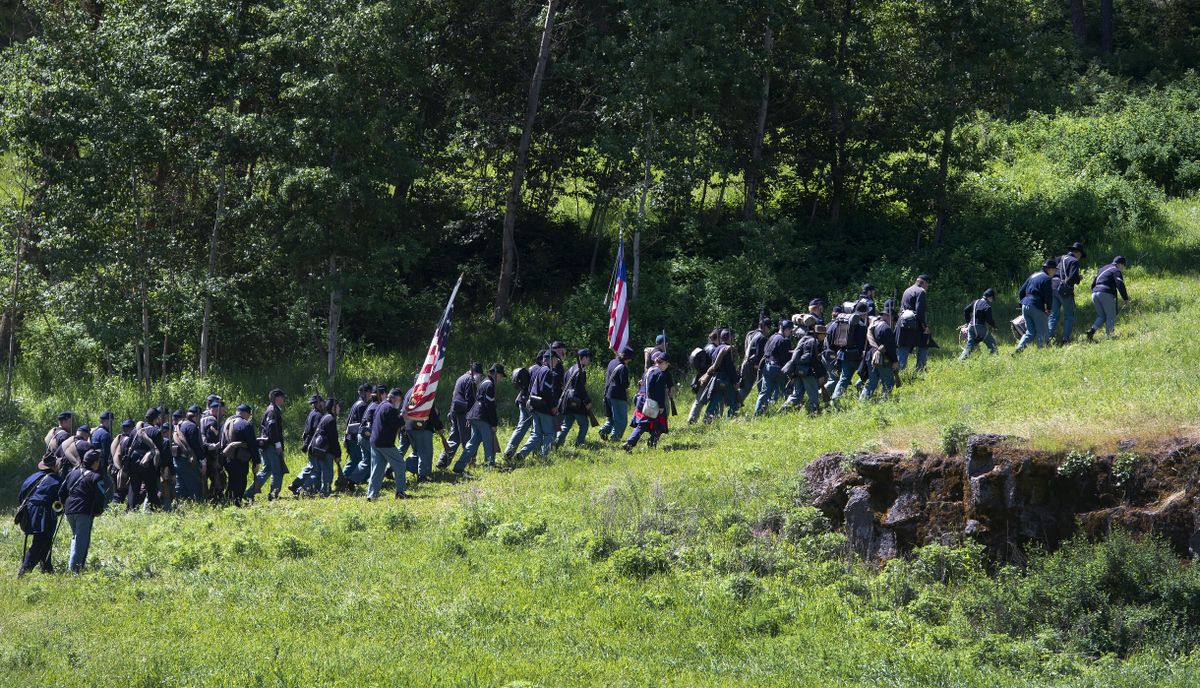At last battle of Deep Creek re-enactment, Union and Confederacy return to Gettysburg

With the thunderous crack of a cannon and the sulfurous pop of a musket, the Battle of Gettysburg was on.
The Union soldiers, clad in various shades of blue, moved slowly up the hill to the tune of artillery fire drowning out a lonely trio of musicians playing the songs of war. Beneath them and occupying a small meadow, Confederate infantry men and women fired in unison to their superior’s command, each snap bringing a flurry of gun powder dancing in the air.
The Battle of Deep Creek, as it’s called, has become a staple of Deep Creek Farm on Memorial Day weekend. Organized in part by the Washington Civil War Association, it brings in hundreds of spectators and volunteers who honor and teach many of the Civil War’s bloodiest skirmishes.
But while the rifles were empty and the artillery nothing more than smoke, the dozens of re-enactors, often shouting at the top of their lungs when pretending to be wounded, or yeehawing and cheering when a shot landed, really sold the action for the crowd of spectators.
As they should. It’s the last year any battle will happen in Deep Creek.
“We couldn’t hope for a more beautiful looking place,” said Darna Michie, who with her husband, Gary, has helped co-organize the event for the past three years. “But we’ll find a place we can all enjoy.”
For 20 years, Michie said the group’s Civil War re-enactments have been happening around the Spokane area, but lately it’s had trouble finding funding. She said she was hopeful they’d find a new space for next year’s event, but had doubts about new funds, saying they’d need more sponsors to stay afloat.
“This one cost $12,000 alone,” she said. “And we’re about halfway there in recouping.”
A stroll through the grounds, lined with white tents and re-enactors – aged as young as 4 or 5 and as seasoned as 81 – is perhaps more engrossing than most lessons found in history books.
There’s era-accurate medical tents with volunteers dressed as 19th century doctors. There’s a saloon, with wooden tables and chairs for soldiers to take a load off before the next battle.
There’s even an era-specific Gatling gun on display. Built by Gary Michie, who plays a Union major in the First Michigan Artillery, it’s one of the many artillery weapons used in the re-enactments.
“They move your clothes every time they go off,” he said. “They’re quite loud.”
The battle began Sunday morning with Union artillery firing at a group of Confederate soldiers from atop a small hill. Cavalry from both sides rode in a circle, firing at each other and dodging large poofs of smoke where cannon balls were imagined to land.
The Union soldiers backed up the hill while the Confederates flanked them on the left and right. Eventually, after many wounded and deceased fell to the ground, both sides stopped firing and saluted their fallen.
The Battle of Gettsyburg is considered the most important engagement in the Civil War. With over 50,000 casualties on both sides, it eventually led to President Abraham Lincoln appointing Ulysses S. Grant to be his general-in-chief of all Union armies over George G. Meade, who was criticized for not pursuing Robert E. Lee’s crippled army after the dayslong battle.
Keith Deaton, the man who played Lincoln on Sunday and who has traveled the country to impersonate our 16th president, was happy to be a part of the weekend. After the battle, he and Don McConnell, the man portraying Grant, would have their first meeting in front of a crowd of onlookers.
“I like to bring the accurate history to the audience and hopefully keep our heritage alive,” said Deaton, 56. “Hopefully teach the younger generation where our country comes from.”
For the final battle in Deep Creek, Gary Michie said it was important to go out with a bang. A very loud, very old bang.
“Gettysburg was the turning point for the federal army getting their hand on the war and their feet on the ground,” he said. “And the Civil War made the United States the United States. Before that, it was just a group of places.”